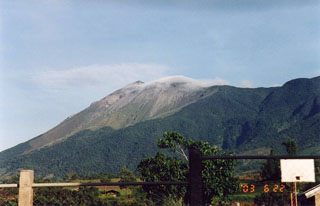Report on Kanlaon (Philippines) — 7 June-13 June 2006
Smithsonian Institution / US Geological Survey
Weekly Volcanic Activity Report, 7 June-13 June 2006
Managing Editor: Sally Sennert.
Please cite this report as:
Global Volcanism Program, 2006. Report on Kanlaon (Philippines) (Sennert, S, ed.). Weekly Volcanic Activity Report, 7 June-13 June 2006. Smithsonian Institution and US Geological Survey.
Kanlaon
Philippines
10.4096°N, 123.13°E; summit elev. 2422 m
All times are local (unless otherwise noted)
Small explosions on 3, 10-11, and 12 June generated steam-and-ash emissions from Canlaon that reached maximum heights of 1 km above the summit (11,300 ft a.s.l.) and drifted NW and SW. Ash fell on the upper SW slopes during 10-12 June. The alert status was raised on 12 June to Alert Level 1 (scale 0 to 5), which restricts activity within 4 km of the summit.
Geological Summary. Kanlaon volcano (also spelled Canlaon) forms the highest point on the Philippine island of Negros. The massive andesitic stratovolcano is covered with fissure-controlled pyroclastic cones and craters, many of which are filled by lakes. The largest debris avalanche known in the Philippines traveled 33 km SW from Kanlaon. The summit contains a 2-km-wide, elongated northern caldera with a crater lake and a smaller but higher active vent, Lugud crater, to the south. Eruptions recorded since 1866 have typically consisted of phreatic explosions of small-to-moderate size that produce minor local ashfall.
Source: Philippine Institute of Volcanology and Seismology (PHIVOLCS)

